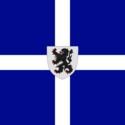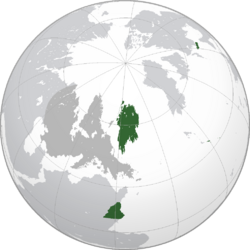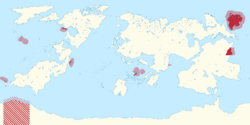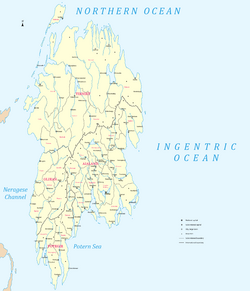Neragon
This article is incomplete because it is pending further input from participants, or it is a work-in-progress by one author. Please comment on this article's talk page to share your input, comments and questions. Note: To contribute to this article, you may need to seek help from the author(s) of this page. |
Kingdom of Neragon Crecle onn Neragon (Neragese) | |
|---|---|
Anthem: X ("Great Flower of Aialand") | |
Location of Neragon (red or dark green) – in Oranland (dark grey) – and its overseas territories and dependencies (red) | |
| Capital | Wilding |
| Largest city | Daughton |
| Official languages | Neragese |
| Ethnic groups (1999)[1] | 47.4% Neragese 18.1% Hessern 16.8% Nicts 5.1% Potern 12.6% Others 3.2% Others |
| Religion (1999)[2] | 72.6% Principalism 13.5% Diogelism 12.3% No religion 1.6% Others |
| Demonym(s) | Neragese |
| Government | Unitary parliamentary constitutional monarchy |
• Monarch | Henry IV |
| John Sonnenfeld | |
| Katarina Horn | |
| Legislature | Parliament |
| Council of Lords | |
| Council of Representatives | |
| History | |
• Kingdom of Aialand established | 14 Phupu 94 CE |
| 21 Kunnen 1298 | |
| 2 Hunyo 1548 | |
| 17 Okjatab 1831 | |
| 13 Marto 1902 | |
| Area | |
• Total | 1,810,655 km2 (699,098 sq mi) (X) |
• Water (%) | 0.99 |
| Population | |
• 1999 estimate | |
• 1999 census | |
• Density | 101.5/km2 (262.9/sq mi) (X) |
| GDP (PPP) | 1999 estimate |
• Total | |
• Per capita | |
| GDP (nominal) | 1999 estimate |
• Total | |
• Per capita | |
| Gini (1999) | medium · X |
| HDI (1999) | very high · X |
| Currency | Tsene (TNE, ₦) |
| Time zone | MTS 0 (Wilding Time) |
| Date format | dd-mm-yyyy |
| Driving side | left |
| Calling code | +1 |
| Internet TLD | .ne |
The Kingdom of Neragon (Neragese: Crecle onn Neragon), known simply as Neragon is and island nation located off the northeastern coast of Oranland. Mainland Neragon consists of the Neragese Isles which consists of the main island of Greater Aialand as well as many smaller islands. Neragon is bordered by the Neragese Strait to the east, the Ingentric Ocean to the west and south, and the Northern Ocean to the north. The total area of continental Neragon is 18,256,177 km2 (7,048,749 sq mi) which is inhabited by 211,833,000 people as of 1999. Additionally, Neragon possesses 7 overseas territories and dependencies, which including continental Neragon makes up the Neragese Empire.
Neragon's history can be traced back to its early tribal origins, when various clans and groups inhabited the region around what is now Aialand. These disparate communities often engaged in tribal conflicts and resource competition. However, the turning point came with the unification of these tribes under the leadership of King Aldor the Great in 94 CE. Aldor's reign marked the beginning of the Kingdom of Aialand, establishing the central authority that laid the foundation for the nation's governance and culture. Over the centuries, Neragon faced numerous challenges, including external invasions and internal strife, such as the !Roman invasion in 150 CE, which ended in a !Roman stronghold in the west of the country.
The monarchy remained a central institution throughout most of the medieval period, though it transitioned into a constitutional monarchy in 1298 CE, when King Thomas I signed the Grand Accord, granting certain rights and privileges to the noble class. This marked a significant step toward a more balanced and equitable society. The !Roman stronghold in the west persisted for centuries even after the fall of the empire, serving as a constant reminder of external threats as the Kingdom of Ostwng. Additionally, internal conflicts occasionally flared up, with periodic disputes between the monarchy and nobility over the distribution of power and resources. Aialand ceased to exist as a country in 1548 when it absorbed the larger but less populated Kingdom of Tirnikt to the north. This event marked the end of Aialand as an independent country, establishing the Kingdom of Neragon in Wilding. The Kingdom of Ostwng would later be annexed by Neragon in 1675, finally ending the long-standing !Roman presence in the region.
Throughout the 18th and 19th centuries, Neragon experienced significant industrialisation and modernisation, as well as growth as a colonial power. The development of railways, factories, and urban centres transformed the nation into an industrial power. The Neragese monarchy gradually ceded more authority to elected representatives, leading to the establishment of a parliamentary system in 1831. This shift in governance brought about greater political stability and representation for the growing population. The 20th century brought its own set of challenges to Neragon, with their involvement in the Great War, Neragon emerged briefly as the world superpower before the beginning of the !Cold War.
Neragon is a unitary parliamentary constitutional monarchy. Its capital is Wilding which is the largest in the country by area, while the largest city by population is Daughton with an estimated population of 17 million as of 1998. Other major cities include Ostwng, Adaidh, Harhall, Thornburg, Beckham, and Trestwall. Neragon has Gentu's X-largest economy by nominal gross domestic product (GDP), and the X-largest by purchasing power parity. It has a high-income economy and a very high Human Development Index rating, ranking Xth in Gentu. Additionally, it performs well in international rankings of average intelligence, healthcare, life expectancy and human development. It is also the first recognised nuclear state since X and has been a permanent member of the Union of Realms Security Council since its first session in X.
Neragon is a member of many organisations including the Union of Realms, !NATO, X, and the League of Neragese Language Countries.
Etymology
History
Pre-unification
The earliest evidence of early humans in Neragon is located near Botenburg where a Paleolithic site is found dating back to around 170,000 years ago and was that of the Homo nuperni.[8] Modern humans (Homo captiosus) are known to have arrived in Neragon around 50,000 years ago via land bridge from X although the first permanent settlement was only established sometime around 9000 BCE.[9] As Hodiernus Ice Age ends and the ice sheets began to recede, Neragon was separated from the rest of Oranland by the end of the 8th millennium BCE.
The Séanctish people, ancestors of the Nicts, Poterns and Hesserns emerged in Neragon around 6500 BCE. They were characterised by their unique burial practices, which involved placing the deceased in cairns or stone circles, and leaving offerings such as pottery and tools. It was during this time that numerous Neolithic monuments, including the famous Standing Stones of Harhall in 5800 BCE, were constructed.[10]
The first evidence of copper usage in Neragon dates back to around 4750 BCE, ushering in the Chalcolithic.[11] This led to the development of advanced metallurgical techniques and the rise of complex agricultural societies such as the Cuprumics in the central regions of Neragon near around the Daughton River. The Cuprumics were known to have developed a system of irrigation that allowed for efficient crop cultivation.[12]
Around 2400 BCE, bronze was introduced to Neragon by !Greek explorers. The introduction of bronze eventually led to the discovery of iron in Neragon around 1200 BCE. This led to the development of iron smelting, allowing the construction of more durable ploughs, advancing agriculture, as well as the production of better weapons and tools.[13] During the Iron Age which started around 1000 BCE, numerous prominent tribes and clans emerged, including Coshon (present-day Redhull), Norensis (Cliwark), and Aulonia (Harhall). This era of Neragese history saw the development of advanced magical practices such as Zoogurism around the 9th century BCE.[14] One of the most famous Zoogurists in Neragese history was a legendary figure known as the "Bear-wolf". According to folklore, the Bear-wolf was said to have the ability to shapeshift into both a bear and a wolf, and was revered as a powerful protector and healer by many tribes in Neragon.
During the ancient period, Neragon was ruled primarily by clans and tribes. The most prominent of these groups was the Aulonia tribe, which controlled much of the Potern Sea and was known for its advanced trading networks and naval power. Other notable clans and tribes during this era included Varia (Pontbach) and Dorn (Dornville).[15] In 433 BCE, Aulonia established the Potern League, a confederation of clans and tribes in the region that aimed to promote trade and mutual defence. However, the league collapsed in 392 BCE due to conflicts between member states.[13]
The era of tribal rule in Neragon would persist until the 1st century BCE. Aldor the Great of the Dorn clan conquered their neighbouring tribes from 84 to 94 CE, a date which marked the founding of the Kingdom of Aialand.[16]
Kingdom of Aialand
Medieval Neragon
Botenburg Declaration onwards
Great War and 20th century
Geography
TBA
Climate
TBA
Flora & fauna
TBA
Government
Neragon is a unitary parliamentary constitutional monarchy, with a system of government that combines elements of a parliamentary democracy with a constitutional monarchy. The Monarch, currently Henry IV, serves as the head of state. The head of government is the Prime Minister, who is elected for 6-year terms and is allowed to serve a maximum of two terms. They hold executive powers and are responsible for the day-to-day administration of the country. John Sonnenfeld is the current Prime Minister, serving since 1993. The prime minister also appoints members of the Cabinet, who are responsible for specific government departments and functions.
Neragon's government operates under a parliamentary system, with a bicameral legislature known as the Parliament. The Parliament consists of two houses: the Council of Lords and the Council of Representatives. The Council of Lords serves as the upper house of the Parliament and is composed of appointed members, half of which are by the Monarch and the rest by the Prime Minister. They provide a deliberative and advisory role in the legislative process, offering valuable insights and expertise. The Council of Representatives, on the other hand, serves as the lower house of the Parliament and comprises elected representatives who directly represent the interests of the people. They are elected for 4-year terms. In total, there are 530 Parliament members, 175 members of the Council of Lords and 355 members of the Council of Representatives.
Katarina Horn is the incumbent Parliamentary Chairperson, overseeing the proceedings of both the upper and lower houses. Usually, the Chairperson is elected by members of the Parliament for 4-year terms and are allowed to serve multiple terms, as long as they maintain the support of the majority of the Parliament.
The judiciary of Neragon is headed by the Royal Court which serves as the highest court in Neragon. It answers to the executive branch of the government and is responsible for interpreting and applying the law in the country. There are a total of 3,193 county judges in the judiciary of Neragon, 252 state judges, and 48 national judges. The judges are appointed by the Prime Minister on the advice of the Parliament.
Administrative divisions
TBA
Overseas territories and dependencies
TBA
Justice
TBA
Foreign relations
TBA
Military
TBA
Economy
TBA
Energy
TBA
Science and technology
TBA
Transport
TBA
Tourism
TBA
Demographics
TBA
Major cities
TBA
Religion
TBA
Languages
TBA
Magic
TBA
Education
TBA
Healthcare
TBA
Culture
Literature
TBA
Philosophy
TBA
Music
TBA
Art
TBA
Cinema
TBA
Cuisine
TBA
Media
TBA
Sport
TBA
Symbols and national holidays
TBA
References
- ↑ "Results of the 1999-2000 Ethnic Survey". Wilding Journal. 2000. Retrieved 29 Marto 2000.
- ↑ Parkston, Jan (1999). "Religion in Neragon as of 1999". Neragese government. Retrieved 18 Disemba 1999.
- ↑ "1998-1999 Neragese Population Estimate" (PDF). Neragese government. Retrieved 4 Enero 2000.
- ↑ "1999 Neragese Population Report" (PDF). Neragese government. Retrieved 8 Pusper 2000.
- ↑ 5.0 5.1 5.2 5.3 "The Neragese Economy in 1999". Neragese government. Retrieved 12 Marto 2000.
- ↑ "Gini index – Neragon". Gini index. 1999. Retrieved 4 Enero 2000.
- ↑ "HDI Report 1999-2000" (PDF). Union of Realms Development Programme. 16 Disemba 1999. Retrieved 28 Disemba 1999.
- ↑ "The Vetuslithic Site at Botenburg". Neragese Archeology. Retrieved 29 Gunyana 1990.
- ↑ Jones, Denis (1972). "The Great Migration and the Arrival of Homo captiosus in Neragon". Journal of Historical Studies. 15 (2): 45–60. Retrieved 14 Kunnen 1991.
- ↑ Akasuki Seymour (1963). The Emergence of the Séanctish People in Alabon. South Daughton University Press. Retrieved 2 Enero 1992.
- ↑ "Copper Usage in Neragon during the Cuprulithic Age". cobre3.kmx. Retrieved 12 Hunyo 1992.
- ↑ Hensen, Emily (1984). "The Rise of Cuprumic Agricultural Societies in Central Neragon". Historical Perspectives. 8 (1): 23–35. Retrieved 7 Marto 1994.
- ↑ 13.0 13.1 "The History of Neragon: Bronze and Iron Ages". Neragon History Online. Retrieved 30 Disemba 1989.
- ↑ Kunnen, Isthon (1993). "The Emergence of Zoogurism in Neragon". Journal of Magical Studies. 15 (2): 45–62. Retrieved 13 Tebax 1995.
- ↑ Vert, Maria (1991). Neragese Clans and Tribes of Antiquity. Wilding University Press. Retrieved 28 Phupu 1993.
- ↑ Jamesen, Gorden. "King Aldor the Great". biography.cem. Missing or empty
|url=(help) Retrieved 7 Disemba 1995.






